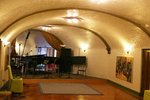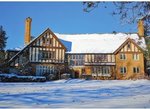

THURSDAY, JULY 16 — Do you have one and a half million bucks to spare? One of Lansing’s grandest and biggest old houses, the 1926 Potter House at 1348 Cambridge St., was listed for sale Wednesday.
Co-owner James McClurken has lived in and cared for the 15,000-square-foot Tudor pile for 12 years, along with his husband, pianist and recording engineer Sergei Kvitko. McClurken said he’s “getting old” (he’s about to turn 70) and has been thinking about downsizing for a while.
“I don’t need this much space, and I’m looking for a less complicated life,” McClurken said.
Caring for the house and its extensive grounds has long been a challenge for McClurken, who considers himself a steward of a community resource more than an owner and takes the house’s preservation seriously.
In his first several years of occupancy, McClurken estimated that he spent about $1,000 a month on restoring and maintaining the house.
“I’ve had to forego a lot of vacations and a lot of other stuff to do this house,” he said. “I want to get out of here while I’m young enough to enjoy it.”
One of Potter House’s most remarkable features is a 2,000-square-foot ballroom on the third floor, the largest single residential room in Lansing. The ballroom has served Kvitko as both concert hall and base of operations for his internationally acclaimed recording studio and Blue Griffin CD label.
But as the music business has changed, Kvitko has shifted more toward bringing his engineering skills to studios and other venues around the country and the world.
“Sergei travels a lot more to do his recordings, and it just doesn’t bear the expense anymore,” McClurken said. Kvitko is now on a swing through the southern United States, producing recordings in Nashville and Louisiana.
One of the city’s biggest and most idiosyncratic homes, Potter House served a stint in the '60s and '70s as a lavish crib for three successive heads of Lansing’s Roman Catholic diocese.
Each room and hallway is enriched by innumerable details, from painted animal murals to Scottish thistles, Moravian star light fixtures and odd Zodiac tiles from Flint Faience.
Much of the detail work, including the murals and the delicate, seven-colored acanthus leaf moldings, had to be restored after brutal makeovers from previous owners.
Sarah Potter, the guiding spirit of Potter House, gave her favorite cat a tenth life by enshrining her likeness in concrete on the front door lintel.
Ray and Sarah Potter commissioned the house in 1926 from Lansing architect Harold Childs. Ray Potter was a timber scout, businessman, banker, benefactor of Sparrow Hospital and founder of the Greater Lansing Foundation, predecessor of the Capital Region Community Foundation.
His father, James Potter, donated Potter Park to the city of Lansing; his grandfather, Linus, settled Potterville. Sarah Potter was a mainstay of the Lansing Woman’s Club and an indefatigable hostess. When Ransom E. Olds hosted Mr. and Mrs. Henry Ford in his home, Olds asked Sarah Potter to be the hostess.
The Potters had no kids, but they used their rambling digs to entertain almost continuously, a tradition McClurken and Kvitko redoubled with an anti-elitist, egalitarian flair. A consultant specializing in Native American issues, McClurken seems to take a tribal view of homeownership.
“The house been a community center for a long time, and we just continued that tradition,” McClurken said.
Hundreds of people drifted through the house for the couple’s New Year’s Eve bashes and thousands more have attended art shows, concerts and fundraisers for organizations as diverse as the Potter Park Zoo, Fenner Nature Center, Peppermint Creek Theatre Co. and various non-profits and political causes.
Potter House can handle a shindig. It was built to industrial, not residential, standards, with bones of steel and concrete.
As soon as McClurken and Kvitko moved in, they had to deal with three disastrous leaks, caused by rampant ivy and consequent wall and ceiling damage. Truckloads of tangled brush, including 20 long-dead elm trees, had to be hauled away.
For several years, McClurken and Kvitko picked a room each year and waded into the ongoing restoration. In 1961, Bishop Joseph Albers had redecorated the house in a modern style, stripping the hardware off the walls and painting the whole house institutional green, including the copper fireplace hood. Fortunately, the bishop stored the fixtures in the attic.
Subsequent owners, the Mussers, introduced a paint scheme so radical McClurken thinks it scared off prospective buyers. McClurken retained tiny traces of Musser’s extreme décor, including a crimson light switch.
In one of the most drastic makeovers in the city’s history, the Mussers turned Bishop Albers’ chapel into a lounge and converted the altar into a rolling bar. They left blood-red walls, blue ceilings, and a bedroom with a portrait of George H.W. Bush over one bed and George W. over the other.
“We thought we might need another exorcism,” McClurken deadpanned.
Outside the walls, McClurken restored 12 original steel-lined garden beds in the front and back yards, and the landscaping never ends.
“I spent way, way, way too much time tending gardens and trimming,” he said. “I’m ready to do much, much less.”
Passers-by often mistake McClurken for a gardener as he works on the grounds, spattered with soil. He often surprises them by offering them an impromptu tour.
He said the listing, announced Wednesday, is a “trial balloon” and he is in no rush to sell, but he added that the house has already attracted national interest.
“We’ll sell it to someone who will appreciate the place, and then they’ll go and change everything,” he said sardonically. “But it’s already been butchered twice, and it’ll come back.”
Support City Pulse - Donate Today!
Other items that may interest you

Comments
No comments on this item Please log in to comment by clicking here